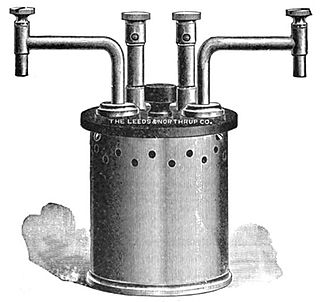Nominal wattage is used to simplify the measurement of the efficiency of a loudspeaker.

A loudspeaker is an electroacoustic transducer; a device which converts an electrical audio signal into a corresponding sound. The most widely used type of speaker in the 2010s is the dynamic speaker, invented in 1925 by Edward W. Kellogg and Chester W. Rice. The dynamic speaker operates on the same basic principle as a dynamic microphone, but in reverse, to produce sound from an electrical signal. When an alternating current electrical audio signal is applied to its voice coil, a coil of wire suspended in a circular gap between the poles of a permanent magnet, the coil is forced to move rapidly back and forth due to Faraday's law of induction, which causes a diaphragm attached to the coil to move back and forth, pushing on the air to create sound waves. Besides this most common method, there are several alternative technologies that can be used to convert an electrical signal into sound. The sound source must be amplified or strengthened with an audio power amplifier before the signal is sent to the speaker.
The impedance of a loudspeaker varies with frequency. This means that if different sine wave tones are fed into the loudspeaker at the same voltage (or the same current), the amount of electric power consumed will vary.

Electrical impedance is the measure of the opposition that a circuit presents to a current when a voltage is applied. The term complex impedance may be used interchangeably.
Frequency is the number of occurrences of a repeating event per unit of time. It is also referred to as temporal frequency, which emphasizes the contrast to spatial frequency and angular frequency. The period is the duration of time of one cycle in a repeating event, so the period is the reciprocal of the frequency. For example: if a newborn baby's heart beats at a frequency of 120 times a minute, its period—the time interval between beats—is half a second. Frequency is an important parameter used in science and engineering to specify the rate of oscillatory and vibratory phenomena, such as mechanical vibrations, audio signals (sound), radio waves, and light.

A sine wave or sinusoid is a mathematical curve that describes a smooth periodic oscillation. A sine wave is a continuous wave. It is named after the function sine, of which it is the graph. It occurs often in pure and applied mathematics, as well as physics, engineering, signal processing and many other fields. Its most basic form as a function of time (t) is:
By convention, loudspeakers are designed to generate the same sound pressure level (SPL) at the listener for the same voltage at varying frequencies - regardless of the variation in electric power. This permits a loudspeaker to be used with an amplifier having a low internal impedance and a flat frequency response is realized for the combined amplifier/loudspeaker system.

An amplifier, electronic amplifier or (informally) amp is an electronic device that can increase the power of a signal. It is a two-port electronic circuit that uses electric power from a power supply to increase the amplitude of a signal applied to its input terminals, producing a proportionally greater amplitude signal at its output. The amount of amplification provided by an amplifier is measured by its gain: the ratio of output voltage, current, or power to input. An amplifier is a circuit that has a power gain greater than one.
Frequency response is the quantitative measure of the output spectrum of a system or device in response to a stimulus, and is used to characterize the dynamics of the system. It is a measure of magnitude and phase of the output as a function of frequency, in comparison to the input. In simplest terms, if a sine wave is injected into a system at a given frequency, a linear system will respond at that same frequency with a certain magnitude and a certain phase angle relative to the input. Also for a linear system, doubling the amplitude of the input will double the amplitude of the output. In addition, if the system is time-invariant, then the frequency response also will not vary with time. Thus for LTI systems, the frequency response can be seen as applying the system's transfer function to a purely imaginary number argument representing the frequency of the sinusoidal excitation.
However, an amplifier with a low internal impedance delivers more electrical output power when the load impedance reduces (until the impedances become approximately matched). Such high power levels could cause damage to either the amplifier or the amplifier's power supply, or the circuit connected to the amplifier's output (including the loudspeaker).

In electronics, impedance matching is the practice of designing the input impedance of an electrical load or the output impedance of its corresponding signal source to maximize the power transfer or minimize signal reflection from the load.
Therefore, an additional convention exists whereby loudspeaker manufacturers specify a conservative estimate of the average impedance that the loudspeaker will present while playing typical music. This is called the nominal impedance. Amplifiers can therefore be safely specified to operate into a load that has this nominal impedance (or higher, but not lower).
Typical nominal impedances for speakers include 4, 6, 8 and 16Ω (ohms), with 4Ω being most common in in-car loudspeakers, and 8Ω being most common elsewhere. A loudspeaker with an 8Ω nominal impedance may exhibit actual impedances ranging from approximately 5 to 100Ω depending on frequency.

The ohm is the SI derived unit of electrical resistance, named after German physicist Georg Simon Ohm. Although several empirically derived standard units for expressing electrical resistance were developed in connection with early telegraphy practice, the British Association for the Advancement of Science proposed a unit derived from existing units of mass, length and time and of a convenient size for practical work as early as 1861. The definition of the ohm was revised several times. Today, the definition of the ohm is expressed from the quantum Hall effect.
In this context, the nominal wattage is the theoretical electric power that would be transferred from amplifier to speaker if the loudspeaker was actually exhibiting its nominal impedance. The actual electric power may vary from about twice the nominal power down to less than one tenth.
Loudspeaker efficiency is measured with respect to nominal power in order to emulate the situation outlined above where a low internal impedance amplifier is used with a loudspeaker. The convention is to supply one nominal watt during testing. If the nominal impedance is 4 ohms, the voltage would be 2 volts. If the nominal impedance is 8Ω, the voltage would be 2.83 volts.





